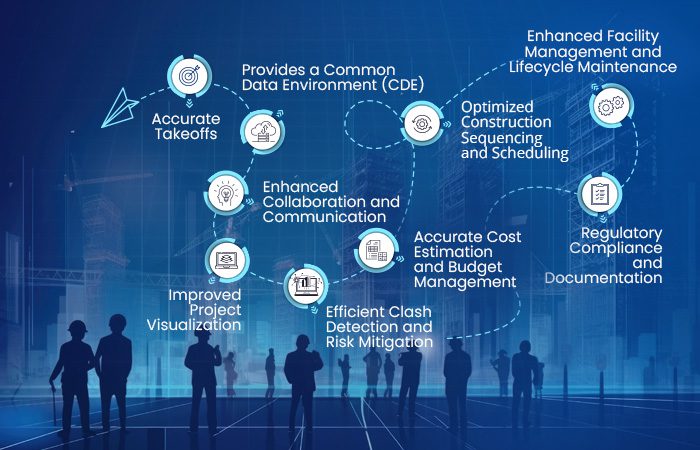
Importance of Building Information Modeling (BIM) for Contractors: Top 9 Benefits
Among the transformative technologies that have reshaped the way we design and construct buildings, Building Information Modeling (BIM) has emerged as a game-changer for contractors. As per reports, the introduction of BIM in construction, in general, reduces error probability in budgeting by 40%, lowers costs by 10%, and reduces construction time by more than 10%. BIM goes beyond traditional 2D drawings, offering a comprehensive digital representation of a building’s physical and functional characteristics.
This blog explores the significance of BIM for contractors, delving into the key benefits that come with this advanced approach to construction.
- Accurate Takeoffs
BIM revolutionizes the accuracy and efficiency of contractors’ takeoff processes. Traditional takeoffs from 2D drawings are prone to errors and may result in inaccurate estimations. BIM, however, provides a three-dimensional digital model that contains comprehensive data on quantities, materials, and components. Contractors can extract precise takeoff information directly from the BIM model, eliminating the guesswork associated with traditional methods. This not only ensures greater accuracy in estimating material quantities but also facilitates quick adjustments in response to design changes.
BIM’s real-time data updates and parametric modeling capabilities empower contractors to streamline the takeoff process, reduce the likelihood of errors, and deliver more accurate and reliable project cost estimates. The result is a more informed and confident approach to bidding and project planning, ultimately contributing to improved project outcomes.
- Provides a Common Data Environment (CDE)
BIM plays a pivotal role in fostering collaboration among contractors by establishing a common data environment (CDE). The CDE serves as a unified platform where all project stakeholders can access, share, and contribute to a singular repository of information. This eliminates the siloed approach to data management, reducing the risk of miscommunication and conflicting data. Contractors benefit from real-time updates, ensuring that everyone works with the latest project information.
The CDE also enhances transparency, enabling seamless collaboration between architects, engineers, subcontractors, and other team members. This centralized approach improves decision-making processes, streamlines workflows, and minimizes the potential for errors. Ultimately, by creating a common data environment, BIM strengthens teamwork, enhances project coordination, and contributes to the successful and efficient delivery of construction projects.
- Enhanced Collaboration and Communication
One of the primary advantages of BIM for contractors lies in its ability to foster enhanced collaboration and communication among various stakeholders involved in a construction project. Traditionally, coordination between architects, engineers, and contractors could be challenging, leading to errors, delays, and cost overruns. BIM, however, provides a centralized platform where all relevant parties can access and contribute to a shared digital model, ensuring seamless coordination from design through construction.
- Improved Project Visualization
Contractors often face difficulties in comprehending complex design plans from 2D drawings alone. BIM addresses this challenge by offering a three-dimensional, visual representation of the entire project. This enables contractors to gain a clearer understanding of the structure, identify potential clashes, and optimize construction sequencing. The enhanced project visualization afforded by BIM helps contractors make informed decisions, reducing the likelihood of errors and rework.
- Efficient Clash Detection and Risk Mitigation
In the traditional construction process, clashes and interferences between different building systems often go unnoticed until the construction phase, leading to costly and time-consuming modifications. BIM enables contractors to perform clash detection early in the design phase, allowing for proactive resolution of conflicts before construction begins. This not only minimizes the risk of on-site clashes but also contributes to a smoother construction process, reducing the likelihood of costly rework.
- Accurate Cost Estimation and Budget Management
Cost overruns are a perennial concern in construction projects. BIM facilitates accurate and detailed cost estimation by integrating project data such as quantities, materials, and labor costs into the digital model.
The National Institute of Building Sciences (NIBS) estimates that for every dollar spent on the design phase of a project, about $5 can be saved during construction, and up to $33 can be saved during the operations and maintenance phase through the use of BIM.
Contractors can analyze and simulate various construction scenarios, helping them make informed decisions to optimize project costs. With real-time cost tracking and management capabilities, BIM empowers contractors to stay within budget and enhance overall financial control.
- Optimized Construction Sequencing and Scheduling
Efficient construction sequencing is crucial for timely project completion. BIM enables contractors to develop detailed construction schedules based on the digital model. By visualizing the entire construction process, contractors can identify potential bottlenecks, optimize workflows, and streamline the construction sequence. This leads to improved project efficiency, reduced construction durations, and ultimately, faster project delivery.
- Enhanced Facility Management and Lifecycle Maintenance
The benefits of BIM extend beyond the construction phase. Contractors can provide clients with a comprehensive digital model that serves as a valuable asset for facility management and maintenance throughout the building’s lifecycle. The digital model contains detailed information about the building components, equipment, and systems, facilitating efficient maintenance planning and operations. This long-term perspective adds significant value to contractors’ services and enhances client satisfaction.
- Regulatory Compliance and Documentation
Meeting regulatory requirements is a critical aspect of construction projects. BIM aids contractors in ensuring compliance by providing a centralized repository for all project-related documentation. From design specifications to material certifications, contractors can manage and track compliance-related information efficiently. This not only simplifies the documentation process but also helps in demonstrating adherence to regulations, mitigating potential legal risks.
Thus, BIM has become an indispensable tool for contractors navigating the complexities of modern construction projects. Its ability to enhance collaboration, improve project visualization, facilitate clash detection, and streamline various construction processes underscores its transformative impact on the industry. By embracing BIM, contractors can unlock unprecedented levels of efficiency, precision, and cost-effectiveness, ultimately positioning themselves at the forefront of innovation in the dynamic world of construction. As the construction industry continues to evolve, those who harness the power of BIM will undoubtedly lead the way toward a future of smarter, more sustainable, and more successful building projects.


